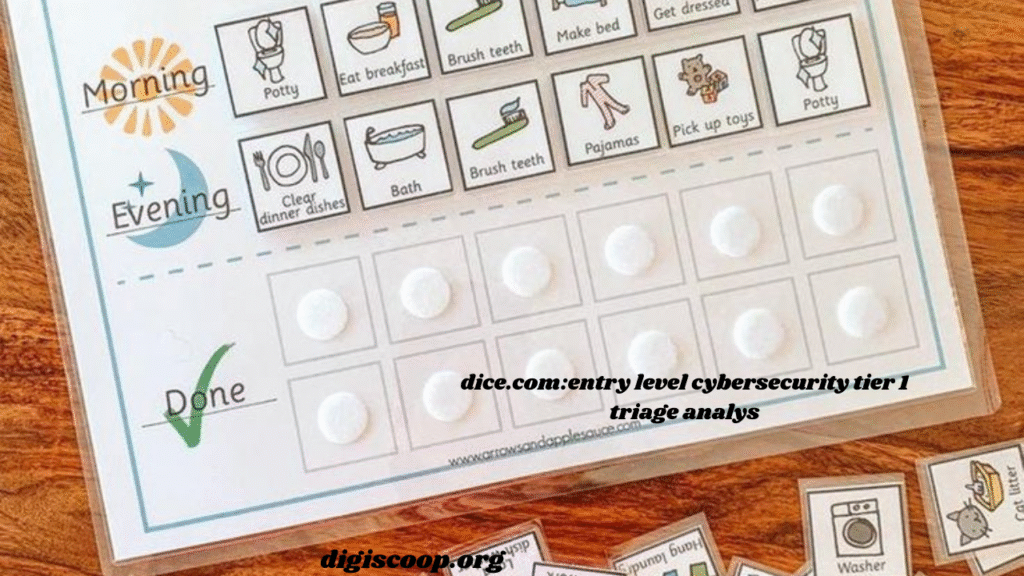Introduction
The demand for cybersecurity professionals has surged in recent years as companies face increasing threats from phishing attacks, ransomware, and insider risks. For many, the first step into this career starts with an entry-level position such as a Tier 1 Triage Analyst. On platforms like dice.com, these roles are often listed as “entry level cybersecurity tier 1 triage analys” jobs, giving newcomers a clear path to begin their journey. This article explores what these positions entail, what skills are required, and how to prepare for them.
Understanding the Role of a Tier 1 Triage Analyst

A Tier 1 Triage Analyst works as the frontline of cybersecurity defense. Their primary job is to monitor, detect, and escalate potential security incidents. They are the first to review alerts generated by Security Information and Event Management (SIEM) systems, intrusion detection systems, and other monitoring tools.
While they may not handle deep forensic investigations, their role is crucial. They must quickly identify whether an alert is legitimate or a false positive and then escalate it to Tier 2 or Tier 3 analysts if needed. This triage process ensures that threats are prioritized and addressed efficiently.
Daily Responsibilities

When you see “dice.com: entry level cybersecurity tier 1 triage analys” in a job listing, here’s what you can typically expect in the role:
- Alert Monitoring: Constantly reviewing SIEM dashboards for suspicious activities.
- Incident Logging: Documenting each event, noting key details for escalation.
- Initial Investigation: Gathering basic information such as IP addresses, log files, and timestamps.
- Escalation: Forwarding confirmed threats to higher-level analysts for deeper investigation.
- Communication: Coordinating with IT and security teams when unusual activity requires immediate action.
These responsibilities make the job fast-paced and often repetitive, but they also provide a strong foundation in cybersecurity operations.
Skills Required for Success

To qualify for a position labeled “dice.com: entry level cybersecurity tier 1 triage analys,” candidates don’t always need advanced technical expertise, but they do need a mix of skills:
- Technical Knowledge
- Basic understanding of networks, firewalls, and endpoint protection.
- Familiarity with SIEM tools like Splunk, QRadar, or AlienVault.
- Knowledge of operating systems (Windows/Linux) and their log structures.
- Soft Skills
- Strong attention to detail to spot anomalies.
- Clear communication for documenting and escalating issues.
- Problem-solving ability to make quick decisions under pressure.
- Certifications (Optional but Helpful)
- CompTIA Security+
- Certified SOC Analyst (CSA)
- CompTIA Cybersecurity Analyst (CySA+)
These credentials are often recommended in job postings on dice.com and can give applicants a competitive edge.
The Career Path Beyond Tier 1
A Tier 1 Triage Analyst role is often the starting point. After gaining 1–2 years of experience, professionals can advance to Tier 2 Analyst, focusing on deeper incident analysis, or Tier 3 Specialist, working on threat hunting, malware analysis, or digital forensics.
From there, career growth could lead to positions such as SOC Manager, Incident Response Lead, or Cybersecurity Engineer. Starting with a Tier 1 role provides the foundation to move into specialized areas of cybersecurity.
Challenges of the Role
Working as an “entry level cybersecurity tier 1 triage analys” comes with certain challenges:
- Alert Fatigue: Analysts often deal with hundreds of alerts daily, many of which are false positives.
- Shift Work: Many SOCs operate 24/7, requiring analysts to work nights, weekends, or rotating shifts.
- High Responsibility: Even at entry level, overlooking a threat can have serious consequences.
Despite these challenges, many professionals see this role as an exciting entry point with rapid learning opportunities.
How to Prepare for a Tier 1 Analyst Role
If you’re browsing dice.com and interested in these positions, here are steps to prepare:
- Hands-On Practice: Use free tools like Security Onion or Splunk training environments to practice.
- Stay Updated: Follow cybersecurity blogs, threat reports, and advisories to understand real-world attacks.
- Apply Broadly: Many employers on dice.com list these positions as entry level, so apply even if you meet only most of the requirements.
Why Employers Value Entry-Level Analysts
Companies need a constant pipeline of new talent to handle the growing number of alerts and incidents. Hiring entry-level analysts ensures that organizations can manage workloads while also training future specialists.
By posting roles like “dice.com: entry level cybersecurity tier 1 triage analys”, employers show they are open to candidates who may not have years of experience but are eager to learn and contribute.
Conclusion
A career as a Tier 1 Triage Analyst is one of the most accessible ways to enter the cybersecurity field. Positions listed under “dice.com: entry level cybersecurity tier 1 triage analys” highlight the importance of these roles in modern security operations. While the work can be demanding, it offers unmatched opportunities to learn, grow, and advance in one of the fastest-growing industries today.
For anyone considering a future in cybersecurity, starting in Tier 1 triage is not just a job—it’s the first step toward building a long-term, impactful career.
Also Read : How Do Resturant Cover Their Smoker Chimney in Winter??







